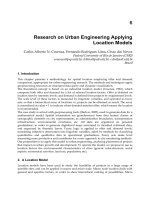Robotics and Automation in Construction 2012 Part 1 pdf
Bạn đang xem bản rút gọn của tài liệu. Xem và tải ngay bản đầy đủ của tài liệu tại đây (3.11 MB, 30 trang )
Robotics and Automation
in Construction
Roboti cs a nd Auto mati on
in Construction
Edited by
Carlos Balaguer and Mohamed Abderrahim
I-Tech
Published by In-Teh
In-Teh is Croatian branch of I-Tech Education and Publishing KG, Vienna, Austria.
Abstracting and non-profit use of the material is permitted with credit to the source. Statements and
opinions expressed in the chapters are these of the individual contributors and not necessarily those of
the editors or publisher. No responsibility is accepted for the accuracy of information contained in the
published articles. Publisher assumes no responsibility liability for any damage or injury to persons or
property arising out of the use of any materials, instructions, methods or ideas contained inside. After
this work has been published by the In-Teh, authors have the right to republish it, in whole or part, in
any publication of which they are an author or editor, and the make other personal use of the work.
© 2008 In-teh
www.in-teh.org
Additional copies can be obtained from:
First published October 2008
Printed in Croatia
A catalogue record for this book is available from the University Library Rijeka under no. 111225071
Robot Manipulators, Edited by Carlos Balaguer and Mohamed Abderrahim
p. cm.
ISBN 978-953-7619-13-8
1. Robotics. 2. Construction I. Carlos Balaguer. II. Mohamed Abderrahim
Preface
Construction is a heterogeneous sector that involves several fields of expertise and input
from other industries. The construction industry is characterised by almost unique circum-
stances for each project and a dynamic unstructured environment, with safety hazards, sev-
eral temporary activities and changing weather conditions. This combination of circum-
stances holds back the introduction of greater automation and robotization in the
construction processes. However, recent years have seen an increase in the use of new tech-
nologies such as ICT, sensory systems, automated machines and robots. Examples of these
special machines include wall climbing robots for inspection and maintenance, concrete
power floating machines, concrete floor surface finishing robots, construction steel frame
welding robots, wall panels’ bricklaying robots, robotic excavators and automated cranes for
the assembly of modular construction elements.
This book addresses several issues related to the introduction of automaton and robotics
in the construction industry in a collection of 23 chapters. The chapters are grouped in 3
main sections according to the theme or the type of technology they treat. Section I is dedi-
cated to describe and analyse the main research challenges of Robotics and Automation in
Construction (RAC). The second section consists of 12 chapters and is dedicated to the tech-
nologies and new developments employed to automate processes in the construction indus-
try. Among these we have examples of ICT technologies used for purposes such as construc-
tion visualisation systems, added value management systems, construction materials and
elements tracking using multiple IDs devices. This section also deals with Sensorial Systems
and software used in the construction to improve the performances of machines such as
cranes, and in improving Human-Machine Interfaces (MMI). Authors adopted Mixed and
Augmented Reality in the MMI to ease the construction operations. Section III is dedicated
to describe case studies of RAC and comprises 8 chapters. Among the eight chapters the sec-
tion presents a robotic excavator and a semi-automated façade cleaning system. The section
also presents work dedicated to enhancing the force of the workers in construction through
the use of Robotic-powered exoskeletons and body joint-adapted assistive units, which al-
low the handling of greater loads.
The new automated machines and processes have the potential to increase productivity
by performing tasks efficiently and improving working conditions through applications that
limit the exposure of humans to safety hazards.
Editors
Carlos Balaguer and Mohamed Abderrahim
RoboticsLab, Department of Systems Engineering and Automation
University Carlos III of Madrid, Spain
{Carlos.Balaguer, Mohamed.Abderrahim}@uc3m.es
VII
Contents
Preface V
The Research Challenges of the Robotics and Automation in
Construction
1. Trends in Robotics and Automation in Construction 001
Carlos Balaguer and Mohamed Abderrahim
2. Construction Automation and Robotics 021
Thomas Bock
3. Mechanising, Robotising and Automating Construction Processes 043
Frans van Gassel and Ger Maas
ICT Technologies, Tools and Sensorial Systems in Construction
4. Powerline Communication in Home-Building Automation Systems 053
Elena Mainardi and Marcello Bonfè
5. Towards n-D Construction Visualization: Cost Integration into 4D Models 071
Katherine A. Liapi and Theodora Paschoudi
6. Developing Construction CAD-Based Experience Management System 087
Yu-Cheng Lin
7. Applications of Computer Aided Design to Evaluate the Zoning of Hazard
Prevention in Community Neighbours
099
Kuo-Chung Wen
8. Adding Value in Construction Design Management by using Simulation Approach 119
Hemanta Doloi
9. Risk and Reliability Analysis of Flexible Construction Robotized Systems 139
Calin Ciufudean
10. Precast Storage and Transportation Planning via Component Zoning Optimization 159
Kuo-Chuan Shih, Shu-Shun Liu and Chun-Nen Huang
11. Pose Estimation of Construction Materials by Acquisition of Multiple IDs of
Devices
175
Tomohiro Umetani, Kenji Inoue and Tatsuo Arai
VIII
12. High Performance Tracking Control of Automated Slewing Cranes 187
Frank Palis and Stefan Palis
13. Enhancing Facility Management Using RFID and Web Technology in Construction
199
Yu-Cheng Lin
14. Improving Human-Machine Interfaces for Construction Equipment Operations with
Mixed and Augmented Reality
211
Xiangyu Wang
15. An Active Technology for Improving the Sound Transmission Loss of Glazed
Facades
225
Berardo Naticchia, Alessandro Carbonari and Sara Spadoni
Case Studies in Robotics and Automation in Construction
16. Development of Adaptive Construction Structure by Variable Geometry Truss 253
Fumihiro Inoue
17. Robotic Excavation 273
Ahmad Hemami
18. Development of a Semi-Automated Cost-Effective Facade Cleaning System 295
Ernesto Gambao, Miguel Hernando and Dragoljub Surdilovic
19. Design and Feasibility Verification of a Knee Assistive Exoskeleton System
for Construction Workers
307
SeungNam Yu, SeungHoon Lee, HeeDon Lee and ChangSoo Han
20. A Robot Application for Analysis, Survey and Conservation of Historical
Architectures
329
Michela Cigola and Marco Ceccarelli
21. Performance Tests for Wireless Real-time Localization Systems to Improve
Mobile Robot Navigation in Various Indoor Environments
355
Yong K. Cho, Jong-Hoon Youn and Nam Pham
22. Laser Energy Transmission for a Wireless Energy Supply to Robots 373
Nobuki Kawashima and Kazuya Takeda
23. Advanced Control Schemes for Cement Fabrication Processes 381
Susana Arad, Victor Arad and Bogdan Bobora
Robotics and Automation in Construction
2
called hard robotics (Balaguer, 2003). These robots tried to automate several construction
processes in the house building and the civil construction. These robots were for interior
building finishing, brick layer masonry, modular industrialized building’s construction,
road paver’s sensor-based guidance, excavator’s control, infrastructure inspection, tunnel
and bridge construction among others. The “bubble economy” crisis en Japan among other
factors such as the unsatisfied over-expectation of the RAC strongly reduced investment in
research activities during the last few years. Only few construction robots had succeeded to
make their way to the market. Nevertheless, the situation is changing now and new RAC
research trends have been launched. The actual R&D activities are centring more in the
software and IT technologies. This is not limited to software only but also include hardware,
but not in the machinery sense. It includes on-site sensory data acquisition and processing,
human operator’s field safety and security, chip-based process control and monitoring,
automated inventory and shop keeping among many others.
The rest of this chapter presents a comparison between the construction and the car
manufacturing industry and discuss some of the issues that limit more technological
advances and higher levels of automation in the construction sector. The following sections
are dedicated to present and discuss some examples of the state of the art in robotics and
automations technologies in construction. The following section discusses some aspects that
affect higher implementation of robotics and automation in construction, and the last section
presents the conclusions.
3. Comparison between the construction and the automobile industries
As mentioned briefly in the previous sections, the construction industry has already seen the
introduction of automated and semi automated means in the production of construction
elements. The transition from totally manual process to nowadays semi-automated system
permits to increase the productivity. Nevertheless, the advance in construction industry is
not comparable to advances in other industries such as manufacturing and especially in the
sectors of automobile, electronics, train, aircraft, etc. The car prices, the number of different
models and variations, and the concept of mass production make the automobile industry
much close to construction than the others.
One of the key factors of any industry’s success evaluation is its productivity. Fig. 1 shows
the comparison of the construction and automobile industries in the EU. This figure clearly
demonstrates that the automobile industry productivity has increased several times more
than that of the construction during the last decade. The main reason in this high
productivity is the modern manufacturing concept: Computer Integrated Manufacturing
(CIM). This concept was developed during the last two decades and has changed not only
the manufacturing process itself but the concept of the product (Rembold et al., 1993), (Rehg,
1994). The CIM systems permit to balance the flexibility in the product with the
manufacturing productivity. This relationship is one of the key factors of the success of the
automobile industry.
While the house-building construction industry continue to be very close to craft work,
constructing mostly singular buildings, the automobile industry continuously seek to reduce
the cost of product development. This permits also to reduce the cost of the final product.
The so called platform concept of the actual automobile industry is one of the newest
advances of the CIM system. It is based on the use of a number of elements in various
models. The same platform design, engine, electronics, etc. are used not only in different
Trends in Robotics and Automation in Construction
3
models of cars of the same company but also in the cars of other companies. This concept
reduces a vehicle cost and makes the automobile companies more competitive.
The high level of integration in all the production stages permits to start from the design
process taking in mind the manufacturing and market aspects. The platform concept and
integration lead to the high level of robotization and automation in automobile industry. In
some of the EU plants the level of automation (the number of non-manually made
operations respect to the total number of operations) is more than 60%. Mass production
brings down the cost not only of the end product (in this case, the cars) but also the cost of
manufacturing equipment (robots, machine tools, etc.). This is why during the last decade
industrial robot prices in the EU have decreased and their number has increased (Fig. 2).
Fig. 1. Productivity of the construction and automobile industries in EU (sources:
Euroconstruct, Eurostat, ACEA)
Fig. 2. Number of industrial robots (IR) in EU and its price in US$ (source: IFR)
Robotics in manufacturing industry is an evolution while the robotics in construction
industry is the not yet finished revolution. While the number of industrial robots is counted
in hundreds of thousands the number of robots in the construction industry is counted in
hundreds only. Important efforts have been made to adapt the CIM concept to the
construction industry created the Computer Integrated Construction (CIC) (Miyatake &
Kangari, 1993) (Balaguer et al. 2002). Unfortunately, this effort has better results only in the
0,90
0,95
1,00
1,05
1,10
1,15
1,20
1,25
1,30
1,35
1,40
1991 1992 1993 1994 1995 1996 1997 1998 1999 2000*
Automobile
Industry
Construction
industry
0,50
0,70
0,90
1,10
1,30
1,50
1,70
1,90
2,10
2,30
2,50
1991 1992 1993 1994 1995 1996 1997 1998 1999 2000*
IR price
Number
of IR
Robotics and Automation in Construction
4
IT related stages of the construction process (planning, suppliers’ relationship, etc.) but not
as good results in the production stages (pre-fabrication technology, building erection,
masonry, on-site automation, etc.). Despite the recent development in RAC, the gap between
the technological levels of both industries is still very high
The CIM concept permits to reduce not only the cost of manufacturing but also changes the
corporate culture (Kangarii, 1996). It is easier to introduce the new technologies in
automobile industry than in the construction. In general, the construction industry
continues to be very conservative. In many cases when the new automatic products are not
complementary to the old ones, they are hardly implemented and their use is kept to
minimum. Moreover, if these products introduce inconveniences to the whole construction
cycle, they are openly refused. To the contrary, in the manufacturing industry the people
and the environment respond very positively to technological innovation. Researchers and
end users speak the same “language” and share the same objective, which allows
introducing these new technologies very quickly.
According to ACEA, in 1999 the EU automobile industry investments in R&D were over 5%
of the turnover while the construction industry investments in house-building technology
were less than 3% (Euroconstruct, 1998). In the construction industry the big companies tend
to limit their capacity to invest in “tomorrow’s construction robots” from which return on
investment is uncertain and too far in the future. This is also the case of the big construction
machines companies, which tend to invest more in civil engineering equipments than in
development of equipments dedicated for house-building.
2. State of the art in construction robotics
The main research activities of the RAC in the past decade were divided accordingly to
applications into two large groups: civil infrastructure and house building. Typical civil
infrastructure robot applications are the automation of road, tunnel and bridge construction,
earthwork, etc. In the group of house construction, main applications include building
skeleton erection and assembly, concrete compaction, interior finishing, etc. Classification
according to applications is consistent with other possible classifications, which divide RAC
R&D activities according to the development of new equipment and processes or the
adaptation of existing machinery to transform them into robotic system.
In this section several examples of robotics systems are presented. In the group of civil
infrastructure the examples are road pavers’ sensor-based guidance, earthmoving control
and infrastructure inspection. In the group of housing the examples are interior building
finishing, brick layer masonry, column welding, modular industrialized building’s
construction.
2.1 Civil infrastructures
In the field of road construction, several projects had been developed over the last decade.
They were mainly focused in the development of the new generation of semi-autonomous
road pavers and asphalt compactors. The EU projects CIRC (Peyret et al., 2003) and latter
OSYRIS (www.osyris.org) had as the main objectives, based in the GPS and laser data, the
semi-autonomous guidance of the machines and the quality control of pavers and roller
processes by controlling the speed, temperature, layer thickness, travelled distance, etc. (Fig.
3). The coordination of several machines in order to improve productivity is also the
objective of the project.
Trends in Robotics and Automation in Construction
5
Fig. 3. OSYRIS project sensor-based compactor
In the field of earthwork the research is centred in the introduction of new control
techniques to existing machinery like excavators, bulldozers, draglines, etc. One of the major
exponents of this research area is the control by CSIRO of the 100-m tall walking crane used
in surface coal mining (Corke et al., 2006). The swing cycle of the dragline accounts for about
80 percent of time taken. The automatic swing cycle improves the efficiency of the machine,
taking in mind that the bucket which weighs around 40 tonnes when empty and up to 120
tonnes when full, acts as a large pendulum and requires operator skill to control well (Fig.
4). The torque-force control during the excavation is also improving the productivity of the
processes. The University of Sydney project (Ha et al., 2000) developed an automated
excavator that accounts for interaction forces in analysing the required bucket motion
therefore seems promising. As the bucket comes in contact with its environment, the contact
force must be regulated such that it remains within a specific range by using specific control
strategy (Fig. 5).
Fig. 4. CSIRO’s dragline project
Robotics and Automation in Construction
6
Fig. 5. the Automated excavator of the University of Sidney
The periodic inspection and maintenance of the civil infrastructures was another important
research activity. The inspection of building skeletons, complex roofs, off-shore platforms,
bridges, etc. represents an extensive and valuable field of work. It is estimated that in the EU
there are over 42.000 steel bridges with a replacement cost of 350 M€. The ROMA family
climbing robots (Balaguer et al., 2000) able to travel in a complex 3D environment carry out
several inspection sensors (laser telemeters, colour cameras) in order to transmit the field
data to the “ground” system (Fig. 6). The key issue of these robots is the grasping method
(grippers, electromagnets, suction cups, etc.).
Fig. 6. ROMA climbing inspection robot
2.2 House building
Interior-finishing operations in the building are very time consuming and requires high
degree of accuracy. There are several mobile manipulators able to perform variety of
operations like extend, compact and control the thickness of the floor concrete, painting and
steel column fire protection spraying, assembly of interior walls and ceilings, etc. Most of
these robots are teloperated and perform only simple operations. The most representatives’
Trends in Robotics and Automation in Construction
7
robots of this type are Japanese ones. Three examples are presented: the "Mighty Hand"
robot from Kajima (www.kajima.co.jp), which lifts heavy elements in construction as
concrete walls, etc. (Fig. 7), and the SurfRobo from Takenaka (www.takenaka.co.jp), which
automatically compact the concrete floor by using two sets of rotary floats (Fig. 8). The right
hand side of the figure shows Kajima´s concrete floor surface finishing robots. These robots
are already used in several building construction sites where they succeeded in releasing
workers from thousands of operations (Hasegawa, 2006).
Fig. 7. Kajima’s interior wall assembly robot
The last decade has witnessed the development of several robots for automatic assembly of
buildings. An effort had been done in the brick laying masonry and the development of
robotic prefabrication of façade and wall ellements. The EU project ROCCO developed a
large-range (10 m reach) and high payload (up to 500 kg) hydraulic 6 DOF robot for brick
assembly (Gambao et al., 1997). The robot is equipped with auto-tracking laser telemeter in
the tip in order to perform prices (up to 5 cm) brick assembly. In this way the control system
avoid important arm flexion. The robot performs the assembly sequence obtained by the
planning software and needs an initialization process in order to know the bricks pallet
position (Fig. 9).
Fig. 8. Takenaka’s concrete compactor robot and Kajima´s concrete finishing robot
Robotics and Automation in Construction
8
Fig. 9. ROCCO project brick assembly robot
During the last few years a tendency to develop wearable robots for different applications
immerged. First this type of robot were thought of from a military point of view, and that is
to provide soldiers with powered exoskeletons to allow them handle heavy loads and resist
longer periods without being exhausted. The main limitation of these robots is their power
supply, but in the construction site this should not be a serious problem, since the robot can
be iambically connected to a power source while being wearied by an operator. A
wearable/exoskeletons robot is able to endow the operator with more strength beyond his
natural limits and allow him/her to handle heavy objects during their construction activities
such as carpentry or fitting ceiling boards as they require large muscular power. The
prototype developed in (Naito et al., 2007) is an example of such application (fig. 10).
Fig. 10. An example of a carpentry aid wearable robot under development
The assembly of steel-based buildings is performing by welding, such as column-to-column
and column-to-beam joints. The Japanese WR mobile robot performs a variety of column-to-
column welding (Fig. 11). The steel columns of up to 100 mm thickness can be round-,
square-, or H-shaped, as well as box-sectional members. For column-to-beam welding, there
is a combination of welder/transport type which can run on decks and a type which can
weld lower flanges from below.
Trends in Robotics and Automation in Construction
9
Fig. 11. WR mobile robot for column welding
Automation and robotization of the complete building erection is the most exciting
experience. Applying to the high-rise building there were several Japanese projects. The
most significant is the SMAT system developed by Shimizu (Miyatake, 1993). It was used for
construction of more than 30 stories office building. It consists of all-wheatear, full-robotic
factory on the top of the building. The lift-up mechanism automatically raises the
construction plant and at the same time raises the on-site factory, called field factory (Fig. 12).
More recently the Dutch companies develop the new whole building erection technology
but in opposite way of the previous system. The building is totally constructed in like
factory environment and then transported to the final location. The 10 floor building called
Bolder was transported by water in a three day operation (Fig. 13).
Fig. 12. SMART factory in the top of the building
Robotics and Automation in Construction
10
Fig. 13. Bolder building transportation by water
3. Software and IT technology in RAC
As discussed in earlier sections, software and IT technologies (also called soft robotics in
earlier publications by the authors) is not only limited to software itself but also includes
other related technology as sensory data acquisition and processing, human operator’s field
safety and security, chip-based process control, etc. This section describes the main
applications and some examples of the actual software and IT trends in the automation of
the construction industry.
3.1 Software integration
Software integration in the field of RAC is crucial for implementing the concept of the
Computer Integrated Construction (CIC). The idea is to integrate in a common exchange
format all the stages of the construction, i.e. from architect’s desk and planning tools to site
robots. The EU FutureHome projects develop the AUTOMOD3 system (Fig. 14) that
integrates in a common CAD environment several tools like design, planning and automatic
robot and machine programming (Balaguer et al., 2002). Due the high level of conservatism
of building designers, the main idea is to use the common 2D architectural design
(drawings) and automatically transform it into 3D drawings. In this way it is possible to
perform also automatically the modularization of the traditionally designed buildings. This
process permits to industrialize the house-building by modular pre-fabricated construction.
Schedule management software packages are used more and more in construction.
Nevertheless, its dynamic integration whit all the actors participate in the construction is not
yet done. In a construction project, although the completion day is clearly decided,
construction schedule is often changed by the weather or the actual progress situation of the
project. When a difference arise between present state and the master schedule, it is
necessary to adjust the construction schedule and to execute it immediately. The
communication with part’s produced factory, transport agents, stores and other suppliers is
performing in real-time and in automatic way (Lipman & Reed, 2000).
Trends in Robotics and Automation in Construction
11
Fig. 14. FutureHome integrated design and planning tools
Mobile computing systems for data transfer between constructor managers and different
web-sites have been implementing. The progress monitoring wireless mobile system
permits to check the progress of the work. At the same time field note system is used to note
unacceptable parts of works (Fig. 15). Inspection system is also used for inspect the result of
construction. The document management system not only can communicate with the
designers DBs in order to download the CAD drawings, but also permits the on-site
modifications of these drawings. This soft technology is very useful and has a low cost
which make it candidate for massive introduction in the site environment. The day when
construction managers and operators carry only some paper drawings will be finished soon.
Fig. 15. PDA-based document management system in the site environment
3.2 Virtual Reality systems
The Virtual Reality (VR) software together with an immersive projection display (IPD)
allows construction managers to enter and interact with the contents of a full-scale building,
Robotics and Automation in Construction
12
before start of the construction or during the execution of the project. The virtual mock-up
offers first person presence, or the feeling that you're actually in the room when you're just
standing in a space bounded by five large screens that surround you with a projected image.
The virtual mock-up experience is real enough to enable welders, for example, to crawl
under virtual structures and hit their heads on virtual pipes to determine if there's enough
room to work. Several immersive VR systems were developed during the last years, like at
the Penn State University (), at the NIST (
equip.html), etc.
a)
b)
Fig. 16. VR environment for excavators training system: a) from inside the cabin, and b)
outside the cabin
In the world of construction operations analysis, the ability to see a 3D dynamic animation
of an operation that has been simulated allows the experts, field personnel, and decision
makers can discover differences between the way they understand the operation and the
way the model developer understands it. The dynamic VR is more close to animation than
geometrical visualization. The actual research is focusing on designing automated, discrete-
Trends in Robotics and Automation in Construction
13
event process simulation-driven methods to visualize construction operations and the
resulting evolving products in dynamic, smooth, continuous, 3D virtual worlds. The
discrete-event simulation systems, allows a computer to create a world that is accurate in
time and space; and which shows people, machines, and materials interacting as they build
constructed facilities.
Using VR system for simulation and training is another software and IT technology (also
designated soft robotics by some authors) area. For complex machines like excavators, the
VR system needs not only to simulate the geometry and kinematics of the machine but also
the terrain and the interaction between the machine and terrain (Lipman & Reed, 2000). The
simulation of digging and driving over the terrain is the crucial test. The terrain model is
generated with an elevation grid technique which specifies a height field over a uniform
grid. If the size of an individual grid in the simulation is smaller than the footprint of the
excavator the system will work correctly and the operator’s sensation will be good. The
system permits the simulation of the view from inside or outside the excavator cabin. To
visually represent the digging process, the location of the bucket relative to the terrain and
relative to the excavator needs to be known. A complete Caterpillar 3D backhoe simulator,
can be consulted at the site page
3.3 Sensory data acquisition and processing
One of the most promising areas of research and development in software and IT in RAC is
the sensory data acquisition and processing. The use of sensors for modelling the
environment and then use this data for processing is much valuable for the control of
automatic construction machinery or robots. The LADAR (Laser Radar) on-site data
acquisition was one of traditional research area at NIST (Cheok at al., 2000). Nevertheless,
only recently this technology has produced important applications in the automatic
excavation, truck guidance, topography and inspection. LADAR technology is based on the
high precision pan-and-tilt mounted laser rangefinder with the frame rate at least 10 Hz
(commonly 25 Hz). The range of the laser scanner is up to 150 m for objects with reflection
coefficient grater than 80% and 50 m for objects with reflection coefficient grater than 10%.
Once the data are registered, they are used to generate 3D models or surfaces (Fig. 17).
Evaluation of surface generation algorithms involves a three parts process. In the first part,
the characteristics (accuracy, noise, and related uncertainties) of the sensor would be
determined. This set up or calibration would be performed in an indoor facility, which
allows for a controlled environment. In the second part, mathematical procedures are used
to determine the statistical uncertainties of particular calculations (e.g., volume) based on
the results of the instrument calibration. In the third part, the characteristics of the
algorithms used to generate the 3-D model would be determined. These characteristics
determine how well the algorithms handle missing points, outliers, discontinuities, vertical
surfaces, etc.
The using of GPS for data collection has become very common. Some applications are very
well known such as automatic truck guidance, topography, etc. But nowadays low-cost
facilities of using PDA-based GPS and web data transmission and collection make new
applications possible. One of these applications is the GPS-aided earthquake monitoring.
The data is collected via a GPS station with a circular antenna firmly fixed in a 4.5 tonne slab
of 300 million year old sandstone from Yorkshire, which is in turn embedded almost three
metres into the earth. This natural landmark is monitored every 15 second via web.
Robotics and Automation in Construction
14
a)
b)
Fig. 17. NIST’s LADAR data: a) environment map, and b) 3D reconstruction
3.4 Safety of operators and machines
Thousands of construction workers are injured or killed in construction accidents each year.
Researches and development efforts have been made in the last few years to look into new
ways of improving the security and developing methods and reliable systems to detect
possible failures and to avoid any harm to the workers, machines and installations. Studies
showed that the main risk sources in on-site environment are collision with the machine
transporting heavy and big objects, fallings, machine running over, and therefore these have
to be taken into consideration when designing preventive security systems (Abderrahim et
al., 2003)
In this research and development effort based on IT and mechatronics systems, the
compulsory safety helmet required for all workers in the site can be used as the base to hold
miniature positioning and communication instruments (Fig. 18) (Abderrahim at al., 2003). In
the work described by the authors, bidirectional voice channel, portable GPS and micro-
camera with video link have been integrated in the security the helmet. The position and ID
of each worker is communicated periodically via radio link to a monitoring station. This
information is compared with a dynamics Data Base containing the tasks and processes to
Trends in Robotics and Automation in Construction
15
be perform in the site. If a given worker is at what the system considers a hazard source it
acts according to the nature of source.
There are two basic security levels: machine and human ones. Machine level refers to the
failures in the machinery, possible erroneous operation, bad condition of the components,
etc. As far as the human level is concerned, the objective is to prevent the operatives from
suffering the accidents. The strategy to adopt consist in the definition of different safe and
prohibited zones around the workers and the sources of danger, so that in the moment in
which these areas comes into contact a danger situation is triggered and warning is
generated. There are several actions to be done in this situation such as advising the worker
thought the voice instructions, halting a machine movement via central computer among
others. The proposed prototype systems records all the detected risk situations for later
examination and is able to be used for monitoring of some activities of the site as it records
the position of workers and automated machines continuously.
Fig. 18. UC3M’s active security system’s elements and a picture of the equipped helmet
3.5 Identification tags and part-oriented construction
One of the most innovative software and IT Technologies applications in the construction
industry is the so called part-oriented construction (Yagi, 2003). The idea is very compatible
with the above mentioned security system, where The main idea is to link the fixed and
temporary facilities of construction site (ground, cranes, field factories, etc.) with the parts-
peoples dynamically changing world via information network. It means that the status,
position and timing of parts and human operators in the site are known in every moment.
Moreover, it is possible to dynamically plan, command, tracking and monitoring all the
construction recourses.
To perform this monitoring each part, machine and operator has assigned an identification
chip which wireless connects with external devices. This chip is a wireless semiconductor
integrated circuit that stores an ID number in its memory (Radio Frequency Identification
Device -RFID). The µ-chip developed by Hitachi is a micro-device with square of 0.4 mm
that uses the frequency of 2.45GHz. It has a 128-bit ROM for storing unique ID (Fig. 19).
The system which controls whole the construction process is called glue logic. This system
binds multiple application software modules, referred as “agents”, developed and compiled
separately, and coordinates those agents. As “glue logic” supports even notification and
conditioning monitoring features based on active data scheme, users can easy build real-
time event-driven application agents. The glue logic consists of two major parts:
VOICE & IMAGES
COMUNICACIÓN
ANTENNA
POSITION
EMITTER
RADIO EMITTER
GPS POSITION
MICROPHONE
HEADPHONES
COLOR
MICROCAMARA
MICROCAMARA
BATTERIES
POSICION
SENDER WIRE
Differential
CORRECCIO
N WIRE
HANDHELD
GPS
ANTENNA
TO / FROM
CONTROL
CENTE
R
Robotics and Automation in Construction
16
communication subsystem exchanging data with concurrently running agents and the data
management subsystem.
Every part has attached µ-chip (which includes antenna). When a chip-implanted part
passes through the gate, the gate reads the product URL. It determines what it is, when and
in what state it is. The corresponding data point in the glue logic is then altered, which
generates an event and a chain of succeeding actions. For communicates with human
operators some of them carry a wireless PDA which is capable to connected to the main web
server where glue logic is running and, at the same time, is capable to read µ-chip attached to
the part. Moreover, the system is applied to automated handling of devices, by
communication with automatic cranes and glue logic DB. The correct assembly of parts is
also be monitoring.
a)
b)
Fig. 19. Hitachi’s RFID μ-chip a) in comparison with the human finger and rice grain, and b)
their application for steel-based parts’ tracking
4. The future of robotics and automation in construction
The automation in construction has moved through several historical periods, according the
ISARC trends (Ueno, 1998): a) cradle (1984-85), b) growing (1986-89), and c) developing
(1990-98). However, even at the time of preparing this document one can assert that the
consolidated has not been achieved yet. This may happen in the near future, but it is
difficult to imagine that the houses will be built in the future like today’s cars. However, as
Trends in Robotics and Automation in Construction
17
illustrated in the examples above the automation in construction is increasing and many of
the developed prototypes will see their way to real application. Some factors are very
important and will affect the way to real implementation in the near future. These factor are
summarised as follow:
• Change of attitude in the construction companies, the machinery industry, the research
centres and the government R&D officials, in order to develop new high tech
commercial products and pass the phase of prototypes.
• Implementation of new IT and telecommunications technologies is already changing
the work process in all the social segments, including the construction people. Today’s
form of work is unimaginable only a few years ago.
• Globalization of the market and consequently adaptation of the commercial structure in
today’s construction sector introduces a very high level of competitiveness, which urges
companies to adopt more automated and efficient means.
To achieve the consolidation period in the construction automation big efforts need to be
made in different fronts:
1. Integration. This is one of the key issues which are necessary to be consolidated during
the next years, being the main lemma “from architect’s desk to site robots”. For this
purpose three main actions should be taken:
1.1 Feedback design of houses, taking into account the prefabrication, erection,
assembly, transportation and other stages of the construction process.
1.2 Diversity of the design using the highest number of the similar standard pre-
fabricated elements (i.e. building different houses with the same parts).
1.3 Software standardization which permit the easy and fast data exchange between
architects, civil engineers, electrical engineers and computer science experts.
2. Pre-fabrication. Expand this technology to cover other materials other than the concrete
(including composites), which shall immediately boost the productivity. Three main
actions are:
2.1 Mass production using pre-fabrication in order to select the parts from a catalogue.
This means that CIM concept must be introduced, including JIT production.
2.2 Standardization of the maximum number of parts through the use of grid
dimensions, common joints, connections, etc.
2.3 2.3. New materials for pre-fabricated parts which make them lighter,
maintaining the same mechanical features.
3. Robots and automated machines. The robots and highly automated machines are the
key issue. Using them ensures a high level of productivity. Some of the main actions
are:
3.1 “Easy” to use robots. Develop robust robots which are easy to control and program
through friendly human machine interfaces.
3.2 Cheap robots. Develop cheap robots which cover single type of application, being
not general. This will permit to increase the sales of units.
3.3 Increasing the level of automation of existing machinery. Modify the conventional
construction machines (cranes, compactors, etc.) in order to convert them into
robotic system.
4.
Investment in R&D. More research and developed investment in RAC both in basic
and applied research through national and international targeted programs, such as the
EU research frameworks. One of the main objectives has to be targeted also at changing









